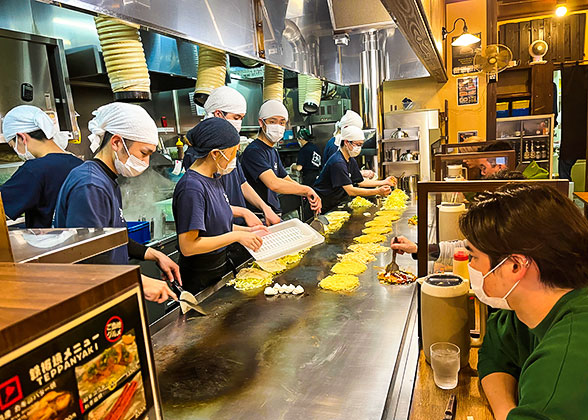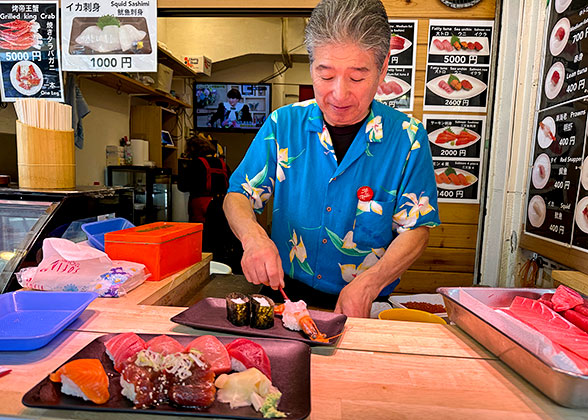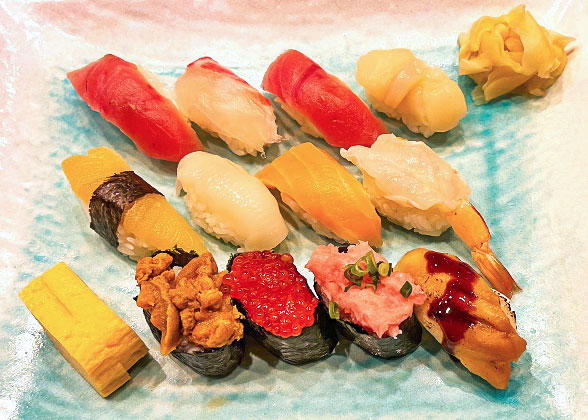Top 10 Japanese Food You Should Have a Try
Here are the best food that you can’t miss when travelling to Japan.1. Sushi – Fresh Ingredients with Rice
Sushi is definitely the most popular Japanese food for overseas. Simply, it’s a mixture of rice with vinegar, fresh fish or meat, and vegetables. The steamed rice is mixed with special sushi vinegar at first, then the rice is kneaded in balls and covered with a thin slice of raw fish, seafood or vegetables. This is just the nigiri sushi, the most widely known type of sushi, eaten with the sauce of soy sauce, wasabi, or more. Maguro – tuna, salmon, shrimps, eel, crab meat, caviars, etc. are most common ingredients to make sushi. Moreover, the rice with sushi vinegar, fresh fish slices, or more ingredients can be rolled up with a layer of nori, too. Then, the roll is cut into a few pieces. There are thousands of sushi restaurants, let alone convenience stores and markets, in Japan, you can enchant your taste buds.
|
|
|
2. Sashimi – Thin Slices of Raw Fishes
Sashimi, the sliced raw seafood, is an artistic Japanese food. In demanding sanitary condition, the fish, salmon, tuna, sea bream, tuna, Arctic shell, snail meat, oyster, etc., is cleaned thoroughly, then cut with professional knife while the bones are removed. The fish slices are dried with special kitchen towel and dished up artistically. The dainty slices, of one fish or various types of fish, are put on the plate, which seems to make an artwork. Usually, some slices of wakame, white radish, and other more vegetables are also added to make the sashimi dish look prefect. Dipped with soy sauce and wasabi, the original flavor of these sea fishes are well preserved. If you are unaccustomed to raw food, you’d better not eat too much. What’s more, it’s not proposed to try the sashimi of fugu – globefish.3. Tempura – Crispy Deep-Fried Fish & Prawns
Delicious and cheap tempura is one of the most popular foods for Japanese. This is a deep-fried snack, Japanese eat it alone with the flavored sauce, or take it as a side dish to the staple food. Shrimps and prawns, the most common ingredients of tempura, are wrapped with a layer of starchy sauce, and then are deep-fried for a while until it becomes golden. Although tempura that you see in restaurants and markets are cooked with shrimps and prawns, sometimes squid, saury, other fishes, tofu, pumpkin, eggplant, onion, or more vegetables are also used. The outside of tempura is golden and crispy, while the inside is tasty with a charming aroma. If you haven't tried tempura yet, try it on your Japan tour!
|
|
|
4. Ramen – Noodles in the Broth
Ramen can be regarded as the most popular and affordable Japanese food in the eastern country, as you can find a ramen shop easily on the streets. The noodles of different thicknesses are served with the soup in different flavors, such as that of fresh fish, tonkotsu – pork bones, miso, and fermented soya beans. Tempura, barbecued pork, sliced meat, or others can also be taken as the toppings on the noodles. Dinners can choose the thickness of noodles, volume, and ingredients according to their preferences, and the cook would rustle them up the ramen immediately. It’s a great enjoyment of your taste, and you can have noodles as it is served.5. Yakitori – Japanese Barbecued Chicken Skewers
In Japan, gourmands like yakitori very much, especially matched with wines and beers. In particular, you could see a long queue in front of yakitori restaurants at the supper time and even late night. Chicken is cut into small pieces and barbecue them with skewers. There are usually two seasoning methods: if you want the original taste of chicken, salt is applied; or if you want a stronger flavor, a salty and sweet soy sauce is added. In some restaurants, all parts of the chicken are on sale, including the breast, wings, heart, butt and chicken skin.
|
|
|
6. Unadon – Grilled Eel over Rice
Do you know what is unagi? It is the Japanese name of local eel, and unadon becomes a favorite food around the country. Japanese believe that eel is packed with vitamins and protein, thus nutritious unadon is also sought-after. The mouthwatering grilled eel segments are put over white rice, and then drizzled with a salty and sweet teriyaki sauce, that’s just unadon. In the past, it was a summer food in Japan, for it was easier to catch eels in summer. Also, Japanese have thought that eel can relieve the fatigue and untoward effects due to summer heat. Now, you can try unadon in any season all over the nation.7. Miso Soup – National Soup Seasoned with Miso
Miso soup is a must among the top Japanese dishes! As the name indicates, it's a soup of miso. It is essential on Japanese’s dining table, and it has been a tradition to drink miso soup when they have meals, regardless of the lunch, dinner, and even breakfast. Miso is the paste made by fermented soybeans and other grains. When the beans go moldy, it is stirred with water and salt, and then sealed for preservation for 1-2 years. Miso tastes sweet or salty, in red or white. As for miso soup, miso is usually added into the soup made from fish or other seafood, carrots, white radish, and even fish bones. It would be an enjoyable to have a miso soup before your meal, which could warm your body and whet your appetite particularly when it turns cold on your journey.8. Sukiyaki & Shabushabu – Hot Winter Food in Japan
If you get to Japan in winter, it’s highly recommended to try sukiyaki and shabushabu. Many ingredients, including the various meats and vegetables, are boiled in the seasoned soup, in the specific pot. Dinners can eat the boiled food materials while boiling other ingredients. Comparatively, soy sauce and granulated sugar are used for sukiyaki, while shabushabu tastes lighter with sesame paste and vinegar.Beef is the major ingredient, for sukiyaki, the beef is boiled with granulated sugar, soy sauce, and more seasonings, later the vegetables are also added. Japanese like to boil beef that dipped in raw egg liquid when having sukiyaki.
There are many types of Japanese shabushabu, which can be classified according to different regions and ingredients. The meat slices are thinned and boiled in the miso soup or kelp stock until cooked, together with tofu and more vegetables, enjoyed with the dipping sauce. In the early days, only beef slices were instantly boiled, while various meat and seafood, like lamb, chicken, octopus and moray, are accessible in shabushabu now.
9. Okonomiyaki – Pancake with Diverse Ingredients
Okonomiyaki is a typical Japanese food cooked on a large iron plate. The paste is smeared on the iron plate, and ingredients including seafood, beef, chicken, bacon, tofu, cheese, corn, onion, cabbage, or other vegetables are added on. Finally, all the things are fried into a thick pancake. As the name indicates, okonomiyaki means everything you like are cooked. Thus, many ingredients can be selected. Drizzled with a brown sauce, mayonnaise, and perhaps more seasonings, the sizzled okonomiyaki is cut into a few pieces when served. Osaka-style okonomiyaki and Hiroshima-style okonomiyaki are the most reputable ones in Japan. Come and have a try.
|
|
|
10. Kare Raisu – Curry Rice in Japanese Style
Although curry originates in India, it has become an important part of Japanese’s daily diet since it was brought into Japan over 150 years ago. In Japan, curry is stewed with beef, potatoes, onion, carrots, or other meat and vegetables. Then, the cooked curry paste is poured over steamed rice. Apart from the strong flavor, another major attraction of Kare Raisu is that, you can cook the curry with whatever you like, such as meat, seafood and vegetables. Thereout, the local featured curry rice mushroomed as curry is paired with various ingredients native to Japan. Fried pork curry, oyster curry, Japanese beef curry, etc. and more creative types can be discovered when you travel to Japan.Read More:
You May Like
-
 10 Days Panoramic Japan Private Tour of Tokyo - Mt. Fuji - Tokyo - Nagoya - Takayama... from USD3756
10 Days Panoramic Japan Private Tour of Tokyo - Mt. Fuji - Tokyo - Nagoya - Takayama... from USD3756 -
 8 Days Mini Group Tour: Tokyo - Hakone & Mt. Fuji - Kyoto - Nara - Osaka - Hiroshima - Osaka from USD2771
8 Days Mini Group Tour: Tokyo - Hakone & Mt. Fuji - Kyoto - Nara - Osaka - Hiroshima - Osaka from USD2771 -
 7 Days Mini Group Tour with Japan Highlights: Tokyo - Mt. Fuji - Kyoto - Nara - Osaka from USD2155
7 Days Mini Group Tour with Japan Highlights: Tokyo - Mt. Fuji - Kyoto - Nara - Osaka from USD2155



